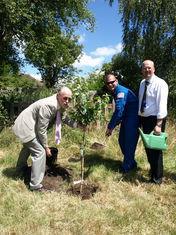
The worlds of space exploration and horticultural research collided at Tunbridge Wells Grammar School for Boys when the school welcomed a NASA astronaut and pilot of possibly the last flight by Space Shuttle Atlantis.
To commemorate the visit of Tony Antonelli from NASA, East Malling Research presented the school with an ‘Isaac Newton Tree’.
The tree presented to the school has been DNA fingerprinted and verified as being from the original tree under which Sir Isaac Newton is believed to have first considered the implications of gravity, which is in Woolsthorpe, Lincolnshire.
A piece of Sir Isaac Newton's original apple tree recently defied gravity, the theory it inspired, when Tony Antonelli’s space mission carried it into space on his last NASA shuttle mission.
Dr Chris Atkinson, chief scientist at East Malling Research, said: “It was great to make the connection between our DNA expertise, epitomised by the Sir Isaac Newton tree; the scientific endeavour and exploration of NASA and arguably one of the world’s most pioneering scientists. I hope that when the pupils look at the tree they will realise that anything is possible through inspiration and hardwork.”
Tony Antonelli, who was visiting the school as part of a national tour, is a veteran of two space flights who has himself experienced weightlessness and the freedom from gravity for 24 days, three hours, 57 minutes and 35 seconds.
In his last flight Tony Antonelli docked with the International Space Station and completed 186 orbits of the Earth, travelling 4,879,978 miles in 11 days, 18 hours, 28 minutes and two seconds.



